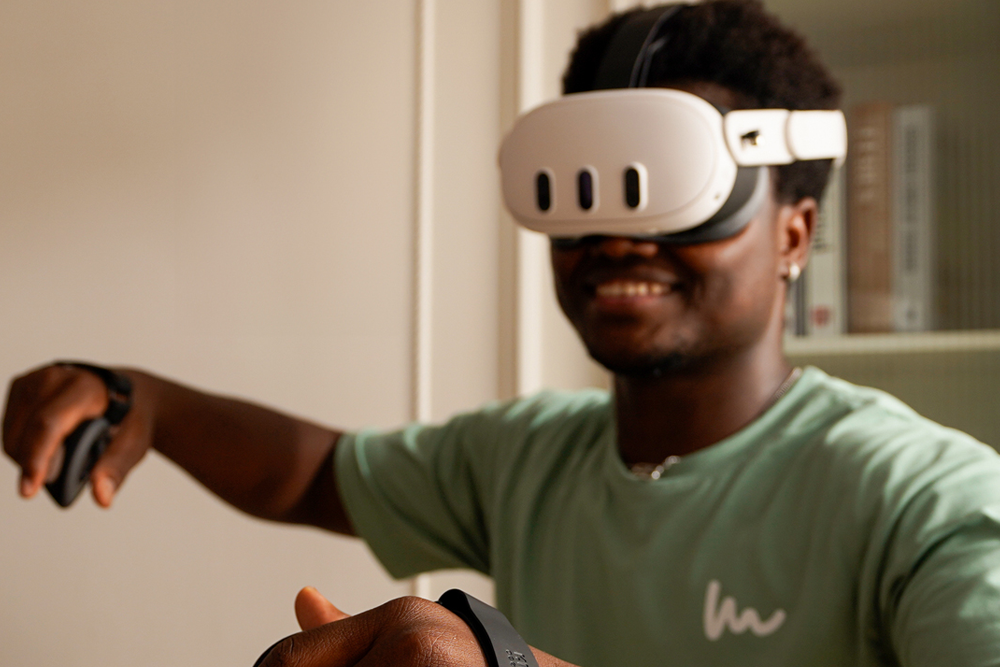Meta’s Quest series has become a top name in the world of virtual reality. The Meta Quest 3 and Meta Quest Pro are two of the latest models, each offering a unique set of features. If you are trying to figure out which headset suits your needs better, understanding the Meta Quest 3 vs. Meta Quest Pro comparison will give you the insights you need to make the right choice.
The Quest 3 is an affordable yet powerful option, catering to casual users and gamers, while the Quest Pro is geared more toward professionals, with enhanced features for multitasking and immersive experiences. Let’s break down the key differences between these two models to help you decide which one fits your needs.
Design and Comfort: Choosing the Right Fit
When it comes to comfort, design matters more than you might expect. The Meta Quest 3 is lightweight, sleek, and simple, offering a familiar design that feels comfortable for short or medium-length VR sessions. The lightweight nature of the Quest 3 helps keep the device wearable for longer periods, but the weight distribution could be improved, especially when compared to the Meta Quest Pro.
The Quest 3’s front-heavy design can cause some users to feel pressure around the forehead or face, making extended use less comfortable. While the adjustable head strap provides decent comfort, there is a chance that users with more sensitive skin may notice some irritation during longer gaming sessions.
In contrast, the Meta Quest Pro’s design focuses heavily on comfort, offering a more balanced weight distribution. The battery is placed at the back of the headset, which reduces pressure on the face, providing a more even feel when wearing the headset.
The Quest Pro also features a more flexible facial interface, which can accommodate users with glasses comfortably. Though the Quest Pro is heavier than the Quest 3, it is more comfortable for long-term wear, thanks to its ergonomic design and better weight balance. If comfort and extended use are your top priorities, the Meta Quest Pro might be more suitable for you.
Performance Power: The Engine Behind The Experience
Performance is where the Meta Quest 3 and Meta Quest Pro start to show their true colors. Both headsets deliver smooth and immersive experiences, but their hardware is designed for slightly different audiences. The Meta Quest 3 comes with the Qualcomm XR2 Gen 2 chip, which is significantly more powerful than the chipset in the Quest 2.
This new processor improves graphics performance, enhances VR gaming experiences, and provides smoother interactions in virtual environments. With a 120Hz refresh rate and the support of higher resolution displays, the Quest 3 shines in delivering visually stunning experiences for users who want immersive gaming and media viewing.
The Meta Quest Pro, however, takes things a step further with the Qualcomm XR2+ Gen 1 chip. This upgraded chip provides a significant boost in processing power, handling demanding applications more efficiently.
With 12GB of RAM compared to the Quest 3’s 8GB, the Quest Pro excels in multitasking, running multiple applications smoothly without lag. If you are using VR for professional or productivity purposes, such as design work or virtual meetings, the Meta Quest Pro will provide the power and capability you need.
Display Quality: A Feast for the Eyes
The display is one of the most important factors in any VR headset, and both the Meta Quest 3 and Meta Quest Pro come equipped with top-tier visual technology. The Meta Quest 3 is outfitted with a high-resolution display that offers 30% more pixels than its predecessor, making images sharper and clearer than ever before.
The Quest 3’s pancake lenses help reduce common visual artifacts like “god rays” and provide a wider sweet spot, which improves the overall image quality. Its 120Hz refresh rate offers a smooth, responsive visual experience, especially in games and apps designed for high-performance VR.
The Meta Quest Pro’s display is equally impressive but focuses more on color accuracy and contrast. The Quest Pro features mini-LED backlighting, which allows for deeper blacks and better dynamic range, delivering a more immersive and cinematic experience.
While the Quest 3’s resolution is higher, the Quest Pro’s color reproduction and contrast levels make it a better choice for those who need realistic visuals, such as designers, architects, or professionals working in VR simulations. If you are someone who values edge-to-edge clarity for gaming or media consumption, the Quest 3 is excellent.
Comfort for Extended Use: No More VR Fatigue
When it comes to extended VR sessions, comfort is key to enjoying your experience. The Meta Quest 3, while lightweight and comfortable for shorter gaming sessions, may leave some users with facial pressure after long hours of play. The standard strap design offers some adjustability, but it may not be enough to alleviate discomfort during extended use.
Though the Quest 3 is a great entry-level device, users who game for hours or use VR for productivity may find it less comfortable after prolonged use. The Quest 3’s front-heavy design means the pressure tends to accumulate around the forehead and cheeks, causing some irritation.
In contrast, the Meta Quest Pro takes comfort seriously. The rear battery design helps balance the weight more evenly, reducing the pressure on your face and ensuring the device remains comfortable throughout longer sessions. The Quest Pro also features an open facial interface, making it easier for glasses wearers to use the headset without discomfort.
The premium materials and ergonomic design make the Quest Pro the better choice for those who plan to use their VR headset for extended periods. Whether for gaming or professional tasks, the Meta Quest Pro has been designed with long-term wearability in mind.
Extra Features and Functionality: What Sets Them Apart
In addition to the core features that define the Meta Quest 3 vs. Meta Quest Pro specs, several extra functionalities distinguish these two headsets, particularly in terms of software and accessibility. The Meta Quest Pro offers several advanced capabilities that make it ideal for professionals and VR enthusiasts who seek more than just a gaming experience.
The Quest Pro introduces advanced mixed-reality capabilities, such as color passthrough, which allows users to blend virtual objects seamlessly into their real-world surroundings. This feature is powered by the Quest Pro’s front cameras, which capture the physical environment around the user and display it in full color. The ability to interact with both physical and digital elements opens up a variety of use cases, especially for applications involving augmented reality.
The Meta Quest 3 also offers mixed reality features, but it falls short in terms of depth and precision when compared to the Quest Pro. The Quest 3 is primarily focused on delivering a great gaming experience with some additional features for casual mixed reality applications, like virtual board games or interactive environments, where the integration of the real world with the virtual world is more for entertainment purposes.
Maintenance: Keeping Your Meta Quest 3 and Meta Quest Pro in Top Condition
Maintaining your Meta Quest 3 or Meta Quest Pro is crucial for ensuring long-term performance and comfort. While both headsets are designed to withstand regular use, proper care will keep them functioning at their best and extend their lifespan.
Another important maintenance step is checking for software updates. Meta regularly releases firmware updates to improve the performance of the devices, fix bugs, and enhance user experience. Both the Meta Quest 3 and Meta Quest Pro will benefit from these updates, which may include performance boosts, security patches, and new features. Ensuring your headset is up to date will help prevent performance issues down the road.
Battery care is also a critical aspect of maintaining your Meta Quest 3 or Meta Quest Pro. The lifespan of the battery can degrade over time if not properly maintained. To maximize battery life, avoid letting the headset’s battery drain completely before recharging. Instead, try to recharge when the battery reaches about 20-30%.
Also, avoid charging the headset for extended periods once it has reached 100% to protect the battery’s health. If you plan to store the headset for a while, make sure the battery is around 50% before doing so to avoid overcharging or deep discharge, both of which can shorten battery life.
Price Consideration: Is the Pro Worth It?
The Meta Quest 3 offers incredible value for its price, making it an attractive choice for casual gamers and those just entering the world of VR. Priced at $500 for the base model, the Quest 3 offers a good mix of performance, comfort, and visual quality.
For users who want a straightforward VR experience without the need for professional-grade features, the Quest 3 is an excellent option that won’t break the bank. For those looking to explore VR without investing too much upfront, the Meta Quest 3 delivers great value.
The Meta Quest Pro comes at a significantly higher price point, around $1,000. However, for professionals or those who demand advanced features like eye-tracking, face-tracking, and more advanced mixed-reality capabilities, the extra investment can be justified.
The Quest Pro’s ability to handle multitasking, its superior build quality, and the inclusion of features that enhance professional and collaborative environments make it a valuable tool for serious users. If you plan to use VR for more than just entertainment, such as in design, architecture, or virtual meetings, the Meta Quest Pro could be the right choice despite the higher cost.
Which One Is Right for You?
Both the Meta Quest 3 and Meta Quest Pro offer impressive features and performance, but they are designed for different types of users.
The Meta Quest 3 is perfect for casual gamers or those new to virtual reality, offering excellent performance, a high-quality display, and an affordable price tag. Its ease of use and solid specifications make it a fantastic entry-level headset for anyone looking to get into VR.
The Meta Quest Pro, however, is built for professionals who need advanced capabilities such as multitasking, eye-tracking, and superior mixed-reality experiences.
While the Quest Pro is more expensive, its performance and design make it an excellent choice for work and productivity. The Quest Pro is ideal for those who need a more refined VR experience, such as virtual meetings, simulations, or collaborative tasks.
If you are looking for top-tier performance and cutting-edge technology, the Meta Quest Pro is the right choice, but for a more affordable, enjoyable gaming experience, the Meta Quest 3 is hard to beat.
KIWI design: Elevating Your Meta Quest 3 and Quest Pro VR Experience
At KIWI design, we provide Quest 3 accessories designed to enhance your experience with both the Meta Quest 3 and Meta Quest Pro. Whether you are looking for more comfort, better battery life, or other upgrades, our products such as the K4 boost battery strap and H4 boost halo battery strap will make your VR sessions even better. Check out our products now to get the most out of your VR experience.




Laisser un commentaire
Tous les commentaires sont modérés avant d'être publiés.
Ce site est protégé par hCaptcha, et la Politique de confidentialité et les Conditions de service de hCaptcha s’appliquent.